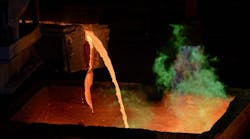Sponsored
Over 30 years ago, Business Week published a disturbing article, entitled, “The Death of Mining (in America).” The narrative spelled out a long list of challenges facing the industry, including excess capacity, weak demand, low prices, environmental laws, foreign competition and the high cost of labor among other issues.
The outlook was dire indeed, not only for copper, but all industrial metals. The commentary concluded with a serious warning that if another broad-based recession were to hit the U.S. in 1985 or 1986 it would probably sound the death knell for an industry that it surmised was already permanently bedridden. As an aside, U.S. Representative Morris Udall, who was chairman of the Interior Committee at that time, was quoted as saying, “We need a copper industry in this country, if for nothing else, but defense purposes.” There was also talk of subsidizing the mining industry.
A few other points of interest when comparing the domestic copper market of 32 years ago to today. In 1984, total production of refined copper stood at 1.63 million short tons, inclusive of 187,000 short tons of smelter production from scrap. Last year, production of refined copper was 1.21 million short tons, but regrettably, scrap smelting no longer exists in the United States. Given the severity of problems facing the industry in the early 1980s, one would have been hard pressed to disagree with the dreadful outlook that prevailed.
Little did we know the seeds of recovery were already being planted when that story ran. Prices didn’t begin rising immediately after the report came out, but instead began consolidating, instead of continuing their decline. Interestingly, many aspects of that article of long ago could be rewritten today, with different names of companies, people, as well as prices and problems that now plague the industry.
I don’t want to delve too deeply into how, when and why the mining industry not only recovered, but went on to enjoy an embarrassment of riches when the stars finally aligned in their favor, but to illustrate that we are in the midst of a cycle that has played out many times before. Further, although the world is very different today than it was 10, 20 or 50 years ago, the one constant that remains in the markets, is human nature — and our inherent emotions of hope, greed and fear.
Why that is, we don’t know, but hope and fear seem to be driving the markets now, and everything we read, hear and see reinforces that negative sentiment. In December, a leading financial publication ran an article on copper, suggesting that more pain was in store for the industry in 2016. It cited a list of issues that will drive prices lower, with some analysts predicting that prices will fall to $1.75, if not $1.50 per pound to force necessary production cuts and restore market balance.
The article concluded with a forecast expecting copper to average $2.06 in 2016. As a point of reference, Spot copper is currently trading at about $2.05 on Comex, and 2015’s annual average price of copper came in at about $2.48, down 62 cents, or almost 26% from about $3.12 in 2014.
You may concur with the pessimistic point of view, and the reality of the situation is not very encouraging. However, a review of other influencing factors, as esoteric as they may be, hints at the potential of higher rather than lower prices in 2016, and if nothing else, some market history helps to maintain an even keel in our thinking.
For example, in December the Federal Reserve finally raised its benchmark lending rate by 25 basis points, representing the first increase since the financial crisis of 2008.
Take a look at the long-term relationship of copper prices to the prime lending rate over the past 45 years. Generally speaking, higher interest rates associate with halting market declines, and often accompany rising copper prices.
Further, over the past 70 years, with the exception of a market disruption caused by massive fraudulent trading, followed by the bursting of the dot.com bubble in 2000, copper has held above its 20-year moving average since 1945.
And if one believes in “regression to the mean,” a review of metal and energy markets illustrates that most have returned, or are close to their long term average prices. Copper has been in a downtrend after peaking at $4.62 per pound in February 2011. In the very short term, we’ve seen copper trade to a low close of $1.98 on a spot basis, with the market falling into oversold territory. Our analysis points to a correction that could take the market back to $2.20, if not higher by the end of the first quarter of 2016. Don’t take this as a price forecast, but just a reading of recent market movements.
Over many years of high-priced experience, one of the most important lessons we have learned is no one really knows what the market is going to do. Similarly, despite logical analysis and the assessment of market fundamentals, quite frequently, markets do not respond logically. Nevertheless, if history is our guide, the seeds of recovery are now being planted, and the next turn of the cycle will be upon us.
Editor’s note. This article was written in mid-December and since then, copper prices have experienced further declines. In a more recent edition of the Copper Journal, John Gross said prices were down 8.8% year-to-date and 26.9% year-over-year.




